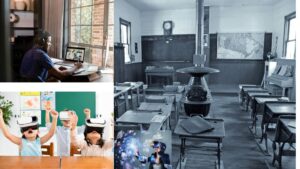
Evolution of Education Describe
Evolution of Education, as a concept, has undergone significant transformations throughout human history. From the rudimentary methods of teaching on cave walls to the sophisticated virtual classrooms of the digital age, the evolution of education reflects the progression of human civilization itself. This article delves into the multifaceted journey of education, tracing its development from ancient times to the modern era, highlighting pivotal milestones, and examining the challenges and opportunities that lie ahead.
Ancient Beginnings:
The roots of education can be traced back to ancient civilizations, where informal methods of knowledge transmission prevailed. In early societies, education was primarily imparted through oral traditions, where elders passed down wisdom, skills, and cultural heritage to younger generations. Cave paintings and inscriptions served as primitive forms of communication and learning, depicting historical events, hunting techniques, and religious rituals. These early educational practices laid the foundation for the development of more structured systems in subsequent civilizations.
Classical Era:
The emergence of organized education can be observed in ancient civilizations such as Mesopotamia, Egypt, Greece, and Rome. In Mesopotamia, the invention of writing led to the establishment of schools known as scribal schools, where scribes were trained in the art of writing and record-keeping. Similarly, in ancient Egypt, scribes played a crucial role in maintaining administrative records and religious texts.
The ancient Greeks made significant contributions to education with the establishment of formal schools such as the Academy by Plato and the Lyceum by Aristotle. These institutions emphasized philosophical inquiry, critical thinking, and the pursuit of knowledge. Meanwhile, in Rome, education focused on training young men in oratory, rhetoric, and citizenship to serve the state.
Middle Ages and Renaissance:
The Middle Ages witnessed the dominance of religious institutions in education, particularly in Europe. Monasteries and cathedral schools became centers of learning, preserving knowledge through manuscript copying and theological study. The advent of universities in medieval Europe, such as the University of Bologna and the University of Paris, marked a pivotal shift towards higher education and intellectual inquiry.
The Renaissance period brought about a renewed interest in classical learning and humanism. Scholars like Leonardo da Vinci, Michelangelo, and Galileo Galilei epitomized the spirit of the Renaissance, blending art, science, and philosophy to advance human knowledge. The printing press, invented by Johannes Gutenberg in the 15th century, revolutionized the dissemination of information, making books more accessible and facilitating the spread of ideas.
Industrial Revolution and Modern Education:
The Industrial Revolution heralded a new era of education, driven by the need for an educated workforce to support industrialization. Mass schooling became widespread, with the adoption of compulsory education laws in many countries. Educational reformers such as Horace Mann in the United States and Johann Heinrich Pestalozzi in Europe advocated for universal education and the development of standardized curricula.
The 20th century witnessed further advancements in education with the proliferation of public schools, the establishment of teacher training colleges, and the introduction of progressive educational theories by figures like John Dewey and Maria Montessori. Technological innovations, such as the overhead projector and the chalkboard, transformed classroom instruction, enhancing visual learning and interactivity.
Digital Age and Online Learning:
The advent of the internet and digital technologies has revolutionized education in the 21st century. Online learning platforms, such as Khan Academy, Coursera, and edX, offer a wealth of educational resources accessible to learners worldwide. Massive Open Online Courses (MOOCs) have democratized education, enabling individuals to pursue learning opportunities regardless of their geographical location or socioeconomic status.
Moreover, the integration of technology into traditional classrooms has led to the emergence of blended learning models, where digital tools complement face-to-face instruction. Interactive whiteboards, educational apps, and virtual reality simulations enrich the learning experience, catering to diverse learning styles and preferences.
Challenges and Future Prospects:
Despite the remarkable advancements in education, significant challenges persist in ensuring equitable access to quality education for all. Disparities in educational attainment based on socioeconomic factors, inadequate infrastructure in underserved communities, and digital divide issues pose barriers to educational equity.
Furthermore, the rapid pace of technological change necessitates continuous adaptation and innovation in educational practices. Educators must embrace lifelong learning and develop digital literacy skills to effectively integrate technology into teaching and learning processes.
Looking ahead, the future of education holds promising opportunities for personalized learning, adaptive assessment methods, and interdisciplinary approaches. Artificial intelligence, machine learning, and data analytics have the potential to revolutionize education by enabling personalized learning experiences tailored to individual student needs.
Evolution of Education Final Concept
The evolution of education reflects the evolving needs and aspirations of human society. From humble beginnings in ancient civilizations to the digital age of virtual classrooms, education has undergone a remarkable transformation fueled by human ingenuity and innovation. As we stand on the cusp of a new era in education, it is imperative to harness the power of technology and embrace pedagogical innovation to create a more inclusive, equitable, and empowering educational landscape for future generations.
